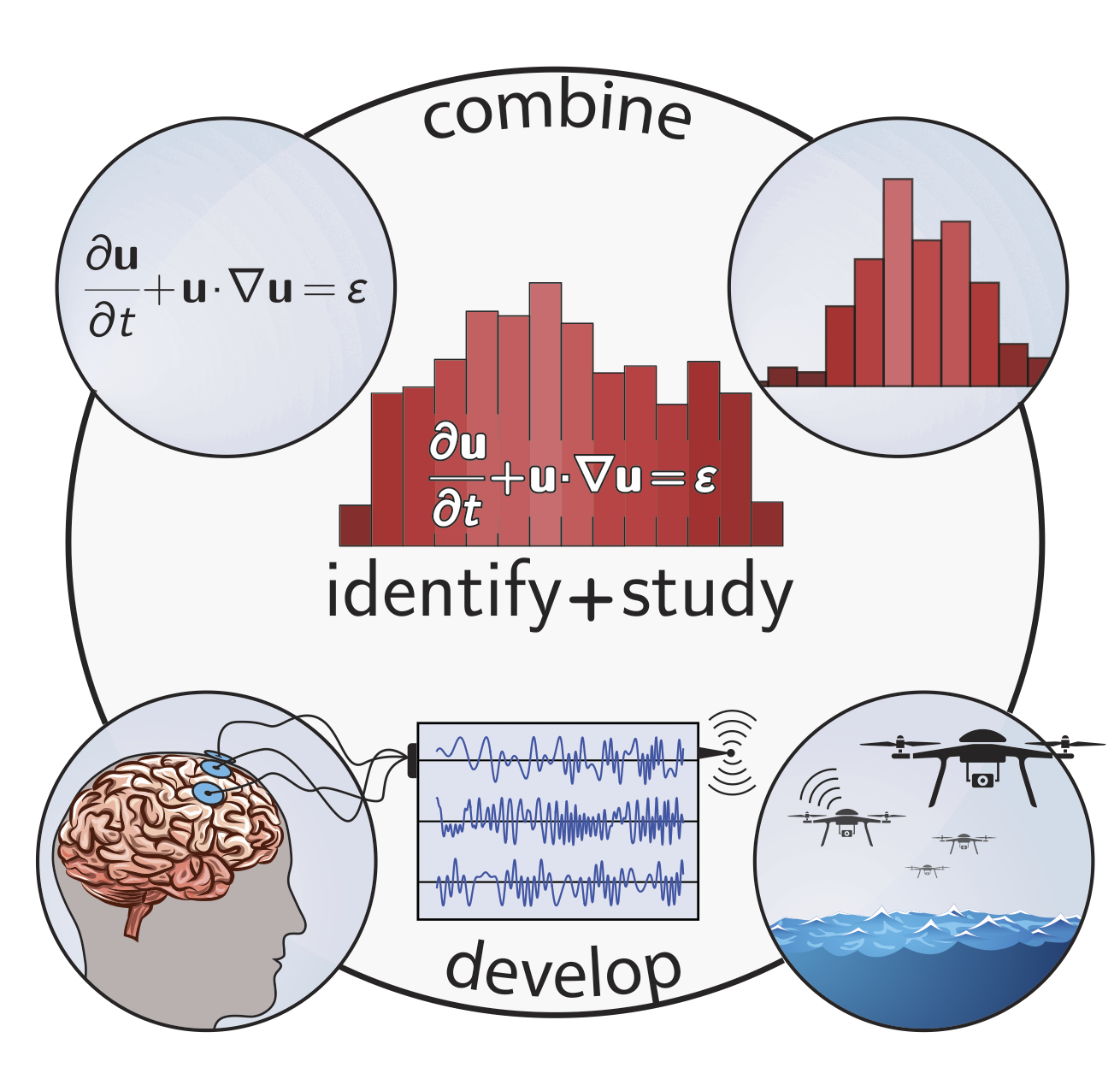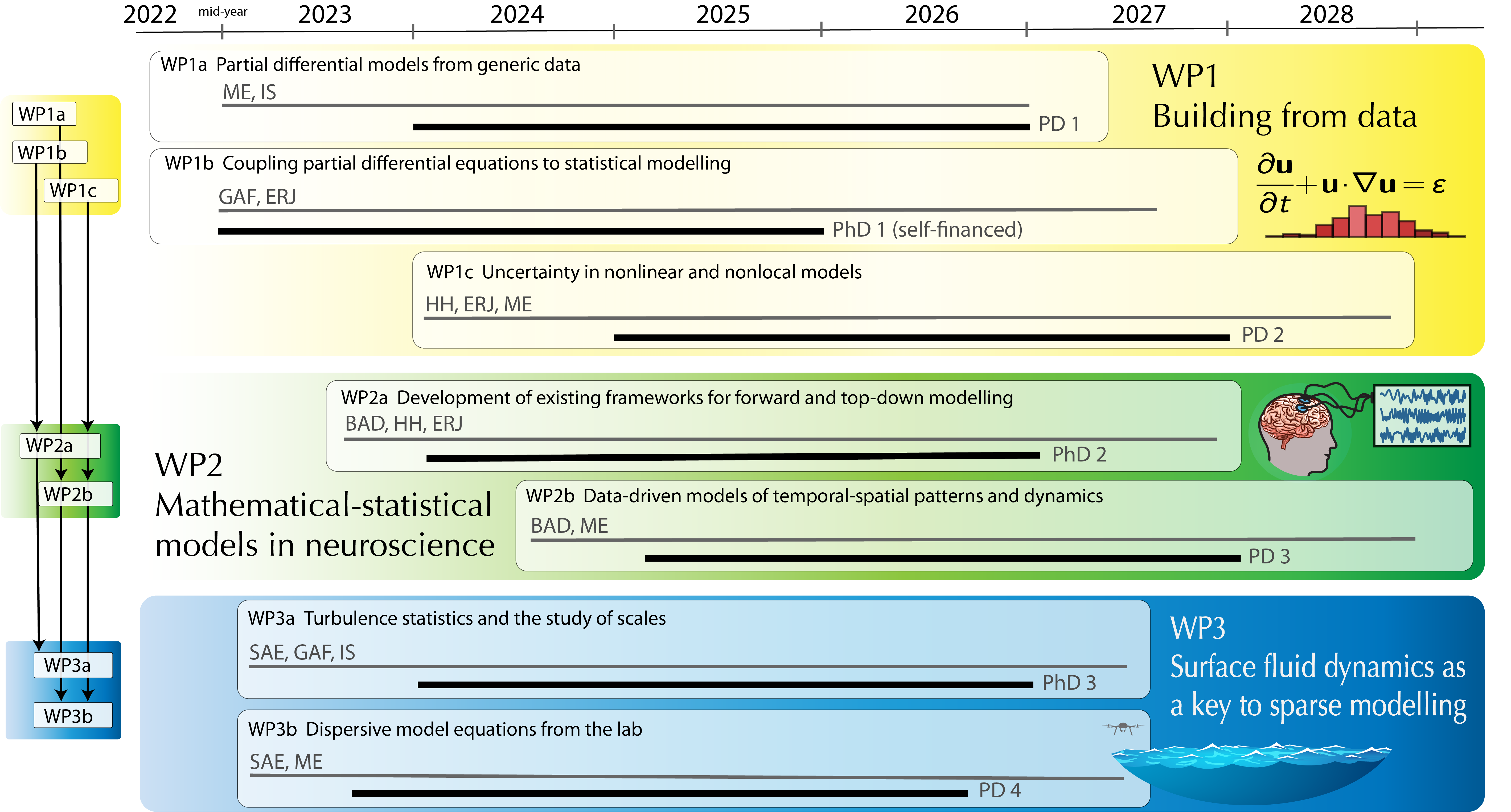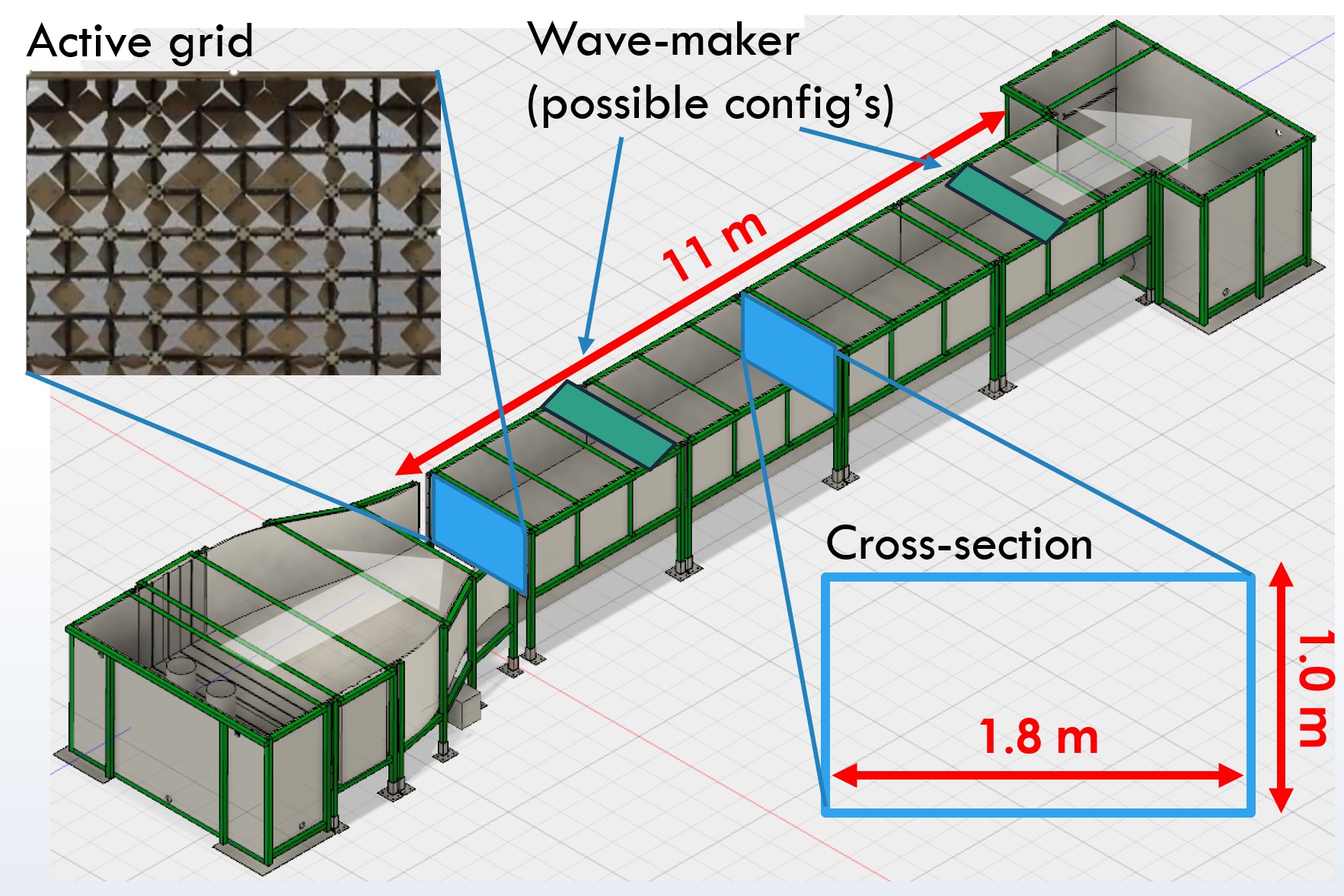IMod – Project information
IMod – Partial differential equations, statistics and data:
An interdisciplinary approach to data-based modelling

Scientific description
IMod is a six-year large-interdisciplinary research project co-funded by the Research Council of Norway through their FRIPRO programme and the Norwegian University of Science and Technology. Its primary objective is to develop novel mathematical-statistical frameworks for data-driven models of complex systems, guided by problems in fluid mechanics and neuroscience. It is divided into three work packages and seven subprojects, each with a junior researcher position employed by the project. Equally many principal investigators are involved, as well as external partners and affiliated junior researchers contributing to the project.
The four main subgoals of the project will be achieved through these subprojects. We will:
- Combine partial differential equations and statistical theory to develop general models with uncertainty for capturing interactions in complex systems.
- Create effective and fast methods to identify physical parameters from sparsely observed phenomena.
- Rigorously study the systems from a mathematical and physical viewpoint.
- Unite theory and data to develop new models in fluid mechanics and neuroscience using tailor-made experiments.
The approximate time plan and activities of the project are illustrated in the following Gantt chart.

The three work packages are described below.
WP1. Building from data
This package is connected to subgoals 1–3 above.
Its first sub-package centers on building Partial differential models from generic data. Time series \(u(t)\) will be captured and described through partial differential equations \( \partial_t u + Lu + N(u) = 0\) where \(L\) is a linear Fourier multiplier operator, and \(N(u)\) is a nonlinear operator, typically realised through a nonlocal pseudo-product. The signal \(u(t)\) is given, and the (parameterised) operators \(L\) and \(N\) are sought as a classification of the signal, or type of signals. The sub-package has one postdoc position directly hired on the project, and is led by Ehrnstrom and Steinsland.
The second sub-package concerns Coupling partial differential equations to statistical modelling. The goal of this sub-package is to develop intrinsic couplings between stochastic partial differential equations, on the one hand, and Gaussian random fields, on the other. A starting point is the connection between covariance Matérn functions used in statistical modelling, and the the class of stochastic, fractional and elliptic partial differential equations \( \tau (\kappa^2 - \Delta)^{\alpha} u(s) = W(s)\) in space. One goal is the extension of this framework to time-dependent settings, another is improved error estimates in the stochastic boundary value problem used when the above stochastic partial differential equation is solved in space. The sub-package has one PhD hired directly on the project, and is led by Fuglstad and Jakobsen.
The third sub-package deals with Uncertainty in nonlinear and nonlocal models. The sub-package focuses mainly on classical PDEs augmented with noise in an appropriate part, and on systems studied and obtained in a process of statistical averaging over many measurements, data points, or agents (such as particles, neurons or nodes). A nonlinear equation driven by noise is the stochastic Camassa–Holm equation \[0 = du + (u \partial_x u + \partial_x P) dt + (\sigma \partial_x u + (1-\partial_x^2)^{-1} (2 \partial_x \sigma u + \partial_x^2 \sigma \partial_x u)) \circ dW.\] A statistically averaged system is the mean field games equations \[\begin{align*}-\partial_t u + |Du|^2 - Lu &= 0,\\ \partial_t m + \mathrm{div}(mDu) - Lm &= 0.\end{align*}\] The sub-package has one postdoc position directly hired on the project, and is led by Holden, Jakobsen and Ehrnstrom.
WP2. Mathematical-statistical models in neuroscience

This package unites the theory from subgoals 1–3 to models in neuroscience in subgoal 4.
Its first subpackage is Development of existing frameworks for forward and top-down modelling. It deals with existing mathematical neuro-science models such as Hudgin–Huxley, Fokker–Planck and Wilson–Cowan equations, as well as existing models for populations of agents (mean-field games) that have not yet been used in the neuro-science setting. Questions of investigation are stability of neural representations under perturbation of noise, and dynamics of representations through different models. The sub-package has one PhD position directly hired on the project, and is led by Dunn, Jakobsen and Holden.
The second sub-package concerns Novel data-driven models of temporal–spatial patterns and dynamics. Its aim is to take one step beyond current state space representations of the brain – which connect features such as neuronal firing-rate to head direction or positions – to models that can possible discover underlying processes and salient features, such as decision making, communication patterns and dynamical fingerprints. The latter exist over time, and would give a dynamical representation of physiological or psychological states or processes. This sub-package also deals with methods for characterising state space representations where the data samples from a mixture of representations; here Bayesian model selection will be used to de-mix populations. The sub-package has one postdoc position directly hired on the project, and is led by Dunn and Ehrnstrom.
WP3. Surface fluid dynamics as a key to sparse modelling
This package unites the theory from subgoals 1–3 to models in fluid mechanics in subgoal 4.
Its first subpackage is Turbulence statistics and the study of scales. The background is the flow of water governed by the Euler and Navier–Stokes equations, in their simplest form written \[\partial_t u + (u\cdot \nabla u) = -\nabla p + F + \nu \nabla^2 u\] Considering turbulence in these equations one may average over slow- and fast-varying scales, yielding the Reynolds-averaged Navier-Stokes equations \[\bar u_j \partial_j \bar u_i = F_i + \partial_j [-p \delta_{ij} + \nu(\partial_j \bar u_l + \partial_i \bar u_j) - \overline{u_l’u_j’}].\] The basic concept is now the covariance matrix \(\mathrm{Cov}(u_i’,u_j’) = \overline{u_l’ u_j’}\). A main aim is to identify variables in the interaction between turbulance and surface waves, that can both be measured experimentally and are amenable to statistical analysis, yielding better and robust models. The sub-package has one PhD position directly hired on the project, and is led by Ellingsen, Fuglstad and Steinsland.
The second subpackage concerns Dispersive model equations from the lab. It builds on the theory of WP1 and the experimental setting of the fluid mechanics lab to build, recapture and improve dispersive model equations directly from physical data. The first step is to regain the known linear dispersion relations for water waves through the mathematical–statistical framework in WP1a; in the second step, we extend the framework to include nonlinear interaction. Finally, we wish to study the interaction between surface and interior to capture models that couple the two using only sparse surface information. The sub-package has one postdoc position directly hired on the project, and is led by Ellingsen and Ehrnstrom.

WP3 makes use of two different laboratories, and this is the larger of them.
Previous activities
Publications
Aggarwal, A., Holden, H., and Vaidya, G. (2025). Error estimates for systems of nonlocal balance laws modelling dense multilane vehicular traffic. Nonlinearity, 38.
Jakobsen, E.R., and Rutowski, A.J. (2025). The master equation for mean field game systems with fractional and nonlocal diffusions. Journal of the European Mathematical Society. In press.
Alibaud, N., Endal, J., Jakobsen, E.R., and Mæhlen, O. (2025). Nonlocal degenerate parabolic-hyperbolic equations on bounded domains. Annales de l'Institut Henri Poincare. Analyse non linéar. In press.
Paulson, K., Li, Z.R., Fuglstad, G.-A., and Wakefield, J. (2025). Temporal Models for Estimation and Short-Term Forecasting of Neonatal Mortality Rates in Sub-Saharan Africa. Annals of Applied Statistics. In press.
Wakefield, J., Gao, P., Fuglstad, G.-A., and Li, Z.R. (2025). The Two Cultures for Prevalence Mapping: Small Area Estimation and Model-Based Geostatistics. Statistical Science. In press.
Mæhlen, O., Varholm, K., and Ehrnstrom, E. (2025). On the precise cusped behaviour of extreme solutions to Whitham-type equations. Annales de l'Institut Henri Poincare. Analyse non linéar, 42.
Li, Z.R., Martin, B.D., Dong, T.Q., Fuglstad, G.-A., Paige, J., Riebler, A., Clark, S., and Wakefield, J. (2025). Space-Time Smoothing of Demographic and Health Indicators using the R Package SUMMER. The R Journal. In press.
Li, L., Bullee, P.A., Ellingsen, S.Å., and Hearst, R.J. (2025). Sub-surface turbulence or non-breaking capillary waves: which dominates air–water gas transfer?. Journal of Fluid Mechanics, 1009.
Chowdhury, I., Jakobsen, E.R., Krupski, M. (2025). A strongly degenerate fully nonlinear mean field game with nonlocal diffusion. Journal of Differential Equations, 440.
Holden, H., and Holden, L. (2025). Optimal rebalancing strategies reduce market variability. The Journal of Finance and Data Science, 11.
Aarnes, J.R., Babiker, O.M., Xuan, A., Shen, L., Ellingsen, S.Å. (2025) Vortex structures under dimples and scars in turbulent free-surface flows. The Journal of Fluid Mechanics, 1007.
Jakobsen, E.R., and Rutkowski, A.J. (2024) Towards a Schauder theory for fractional viscous Hamilton-Jacobi equations. Pure and Applied Functional Analysis, 9.
Aarnes, J.R. (2024). Mathematical sciences as symbolic form: the objects and objectivity of science in Ernst Cassirer’s philosophy of science and culture. Continental Philosophy Review, 57.
Marstrander, J.U. (2024). REMARKS ON SOLITARY WAVES IN EQUATIONS WITH NONLOCAL CUBIC TERMS. Journal of Computational Dynamics, 3.
Chowdhury, I., and Jakobsen, E.R. (2024) Precise Error Bounds for Numerical Approximations of Fractional HJB Equations. IMA J. Numer. Anal.. DOI: 10.1093/imanum/drae030.
Ellingsen, S.Å., Zheng, Z., Abid, M., Kharif, C., and Li, Y. (2024). Dispersive Wave Focusing on a Shear Current: Part 1—Linear Approximations. Water Waves, 6.
Aggarwal, A., Holden, H., and Vaidya, G.K. (2024). Well-posedness and error estimates for coupled systems of nonlocal conservation laws. IMA Journal of Numerical Analysis, 44
Weichert, S., Smeltzer, B.K., and Ellingsen, S.Å. (2024). The Effect of Horizontal Shear on Extracting Water Currents from Surface Wave Data. IEEE Transactions on Geoscience and Remote Sensing, 62
Zheng, Z., Li, Y., and Ellingsen, S.Å. (2024). Dispersive Wave Focusing on a Shear Current: Part 2—Nonlinear Effects. Water Waves, 6
Marstrander, J. (2024). Solitary waves for dispersive equations with Coifman–Meyer nonlinearities. Discrete and Continuous Dynamical Systems. Series A, 44.
Hanche-Olsen, H., and Holden, H. (2024). The Aubin-Lions-Dubinskii theorems on compactness in Bochner spaces. Pure and Applied Functional Analysis, 9.
Galimberti, L., Holden, H., Karlsen, K., and Pang, H.C. (2024). Global existence of dissipative solutions to the Camassa–Holm equation with transport noise. Journal of Differential Equations, 387.
Holden, H., and Risebro, N.H. (2024). The continuum limit of non-local Follow-the-Leader models. ESAIM: Mathematical Modelling and Numerical Analysis (ESAIM: M2AN), 58.
Chowdhury, I., Jakobsen, E.R., and Lien, R.Ø. (2024). Discretization of Fractional Fully Nonlinear Equations by Powers of Discrete Laplacians. Dynamic Games and Applications, 15.
Chowdhury, I., Jakobsen, E.R., and Krupski, M. (2024) On fully nonlinear parabolic mean field games with examples of nonlocal and local diffusions. SIAM J. Math. Anal., 56(5):6302–6336.
Bullee, P.A., Weichert, S., Nore, A., Li, L., Ellingsen, S.Å., and Hearst, R.J. (2024). The influence of water turbulence on surface deformations and the gas transfer rate across an air–water interface. Experiments in Fluids, 65.
Aarnes, J.R. (2024). Ernst Cassirer and Structural Realism. Cahiers de sémiotique des cultures, 2.
Alibaud, N., Endal, J., and Jakobsen, E.R. (2024) Optimal stability results and nonlinear duality for L-infinity entropy and L1 viscosity solutions. J. Math. Pures Appl., 188:26–72.
Altay, U., Paige, J., Riebler, A., and Fuglstad, G.-A. (2024) GeoAdjust: Adjusting for Positional Uncertainty in Geostatistial Analysis of DHS Data. The R journal.
Altay, U., Paige, J., Riebler, A., and Fuglstad, G.-A. (2024) Jittering Impacts Raster- and Distance-based Geostatistical Analyses of DHS Data. Statistical Modelling, 25.
Pizzo, Nick; Lenain, Luc; Rømcke, Olav; Ellingsen, Simen Andreas Ådnøy; Smeltzer, Benjamin Keeler. (2023) The role of Lagrangian drift in the geometry, kinematics and dynamics of surface waves. Journal of Fluid Mechanics, 954.
Spitieris, M., and Steinsland, I. (2023). Bayesian Calibration of Imperfect Computer Models using Physics-Informed Priors. Journal of machine learning research, 108.
Aggarwal, A., Holden, H., and Vaidya, G.K. (2023). On the accuracy of the finite volume approximations to nonlocal conservation laws. Numerische Mathematik, 156.
Zhang, J., Bonas, M., Bolster, D., Fuglstad, G.-A., and Castruccio, S. (2023) High Resolution Global Precipitation Downscaling with Latent Gaussian Models and Nonstationary SPDE Structure. Journal of the Royal Statistical Society: Series C, 73.
del Teso, F., Endal, J., Jakobsen, E.R., and Vazquez, J.L. (2023) Evolution Driven by the Infinity Fractional Laplacian. Calc. Var., 62(136).
Babiker, O., Bjerkebæk, I., Xuan, A., Shen, L., and Ellingsen, S.Å. (2023). Vortex imprints on a free surface as proxy for surface divergence. Journal of Fluid Mechanics, 964.
Lenain, L., Smeltzer, B.K., Pizzo, N., Maria, F., Colosi, L., Ellingsen, S.Å., Grare, L., Peyriere, H., and Statom, N. (2023) Airborne Remote Sensing of Upper-Ocean and Surface Properties, Currents and Their Gradients From Meso to Submesoscales. Geophysical Research Letters, 50.
Weichert, S., Smeltzer, B. K., and Ellingsen, S. Å. (2023) Biases from spectral leakage in remote sensing of near-surface currents. IEEE Transactions on Geoscience and Remote Sensing.
Zheng, Zibo; Li, Yan; Ellingsen, Simen Andreas Ådnøy. (2023) Statistics of weakly nonlinear waves on currents with strong vertical shear. Physical Review Fluids, 8.
del Teso, F., Endal, J., and Jakobsen, E.R. (2023) Uniform tail estimates and Lp-convergence for finite-difference approximations of nonlinear diffusion equations. Discrete Contin. Dyn. Syst., 43(3&4): 1319–1346.
Smeltzer, Benjamin Keeler; Rømcke, Olav; Hearst, R. Jason; Ellingsen, Simen Andreas Ådnøy. (2023) Experimental study of the mutual interactions between waves and tailored turbulence. Journal of Fluid Mechanics, 962.
Ehrnstrom, Mats; Nik, Katerina; Walker, Christoph. (2022). A direct construction of a full family of Whitham solitary waves. Proceedings of the American Mathematical Society, 151(2).
Ehrnstrom, Mats; Nilsson, Dag; Groves, Mark D. (2022) Existence of Davey–Stewartson type solitary waves for the fully dispersive Kadomtsev–Petviashvilii equation. SIAM Journal on Mathematical Analysis, 54(4).
Ehrnstrom, Mats; Wang, Yuexun. (2022) Enhanced existence time of solutions to evolution equations of Whitham type. Discrete and Continuous Dynamical Systems. Series A, 42(8).
Paige, J., Fuglstad, G.-A., Riebler, A., and Wakefield, J. (2022). Spatial Aggregation with Respect to a Population Distribution: Impact on Inference. Spatial Statistics, 52.
Preprints
Auestad, Ø.S., Fuglstad, G.-A., Lang, A. (2025) Surface finite element approximation of parabolic SPDEs with Whittle--Matérn noise. arXiv:2510.08443.
Auestad, Ø.S. (2025) An L0-approach to stochastic evolution equations. arXiv:2508.16458.
Auestad, Ø.S., Fuglstad, G.-A., Jakobsen, E.R., and Lang, A.. (2025) Finite element approximation of parabolic SPDEs with Whittle–Matérn noise. arXiv:2406.11041.
Furset, S.K. (2024) Spectral approximation of a new class of stochastic fractional evolution equations. arXiv:2406.19799.
Auestad, Ø.S. (2024) Numerical approximation of linear parabolic evolution equations revisited. arXiv:2406.02796.
